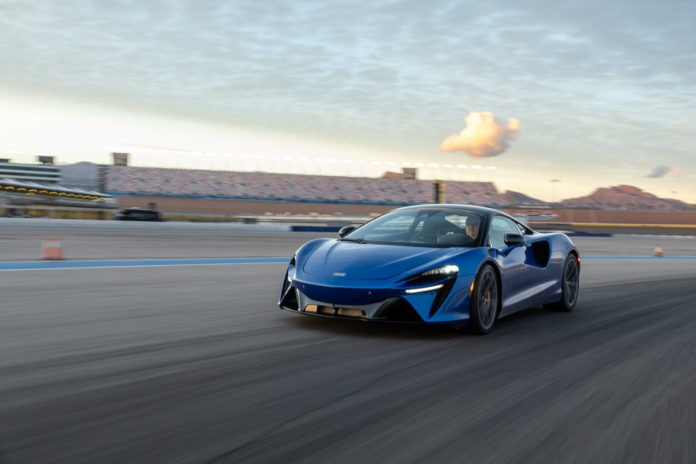Born of a racing team, McLaren builds cars based on racing principles. In the name of speed, they are light and powerful, and McLaren goes one step further by making them fun and engaging. With the 2023 Artura, McLaren doubles down on both the fun and the race car engineering while adding a plug-in hybrid powertrain for the first time in one of its series production cars.
The result is a supercar with multiple personalities. It can be a relatively comfortable every day driver, an immensely capable track machine, or even an economy car with about as much power as a Smart ForTwo.
2023 McLaren Artura
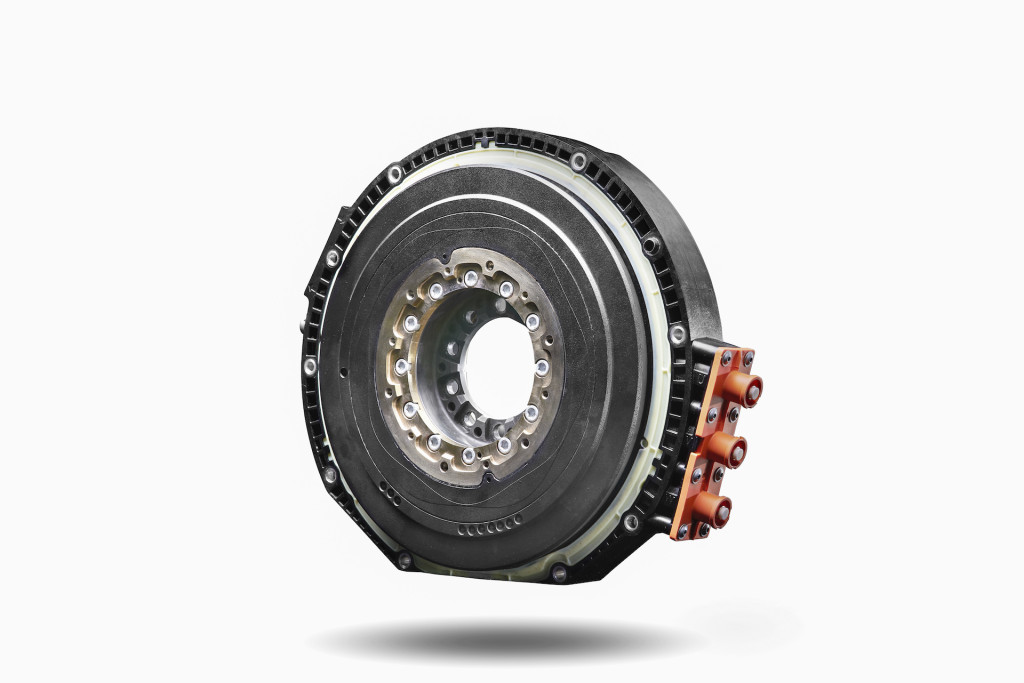
2023 McLaren Artura
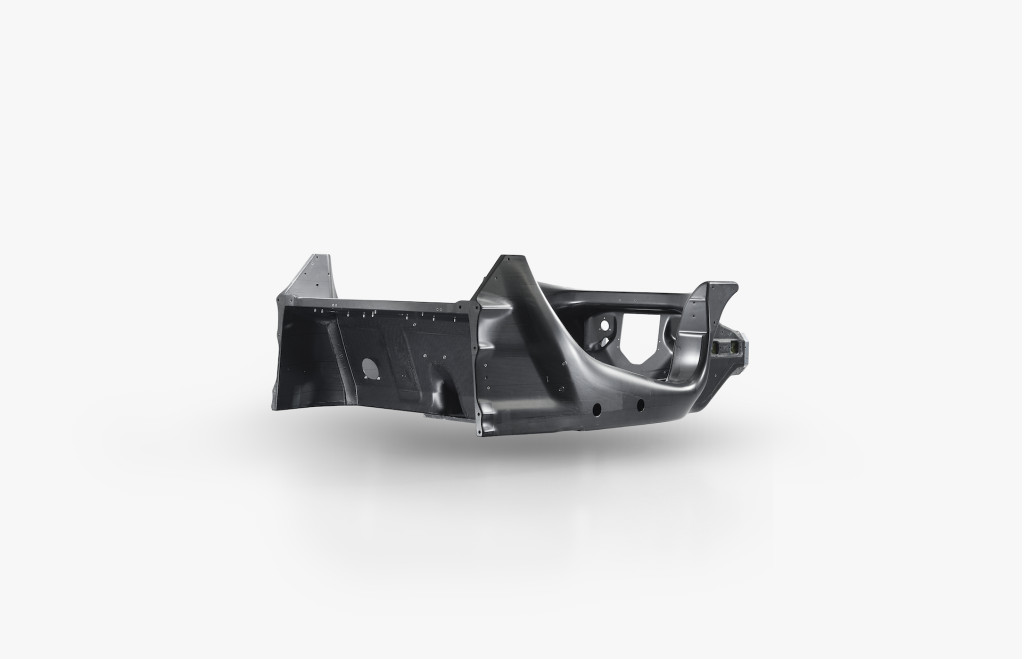
2023 McLaren Artura
The next generation of McLaren
McLaren’s first next-generation car starts with a new carbon-fiber tub, the first since the brand was founded a decade ago. The so-called McLaren Carbon Lightweight Architecture (MCLA) incorporates a protection cell for the car’s 7.4-kwh battery. It’s built more efficiently from fewer pieces of carbon fiber, and it weighs about 10% less than the first-gen tub. It’s also stiffer, but McLaren isn’t saying by how much.
MCLA provides a home for a new plug-in hybrid powertrain that offers about three times as much electric power as the brand’s first attempt at electrification, the limited-edition, $1.15 million, 903-hp P1 hypercar from 2013.
A new 3.0-liter twin-turbo V-6 replaces the familiar twin-turbo 4.0-liter V-8 in McLaren’s other cars. The engine’s 120-degree V spreads it out wide and helps it sit about two inches lower than the V-8. With two fewer cylinders, it also stretches 7.5 inches shorter, and with a hot V design instead of outboard-mounted turbos, it’s 8.7 inches narrower. On its own, the engine makes 577 hp and 431 lb-ft of torque.
The V-6 also weighs about 110 pounds less than the V-8, and its low position, which is also aided by a dry-sump oiling system, helps keep the car’s center of gravity low.
The engine is mated to a new 8-speed dual-clutch transaxle that also incorporates an electronically controlled limited-slip differential. Sandwiched between the engine and transmission, the axial flux electric motor sits within the transmission housing. It produces 94 hp and 166 lb-ft of torque that can be accessed at any time.
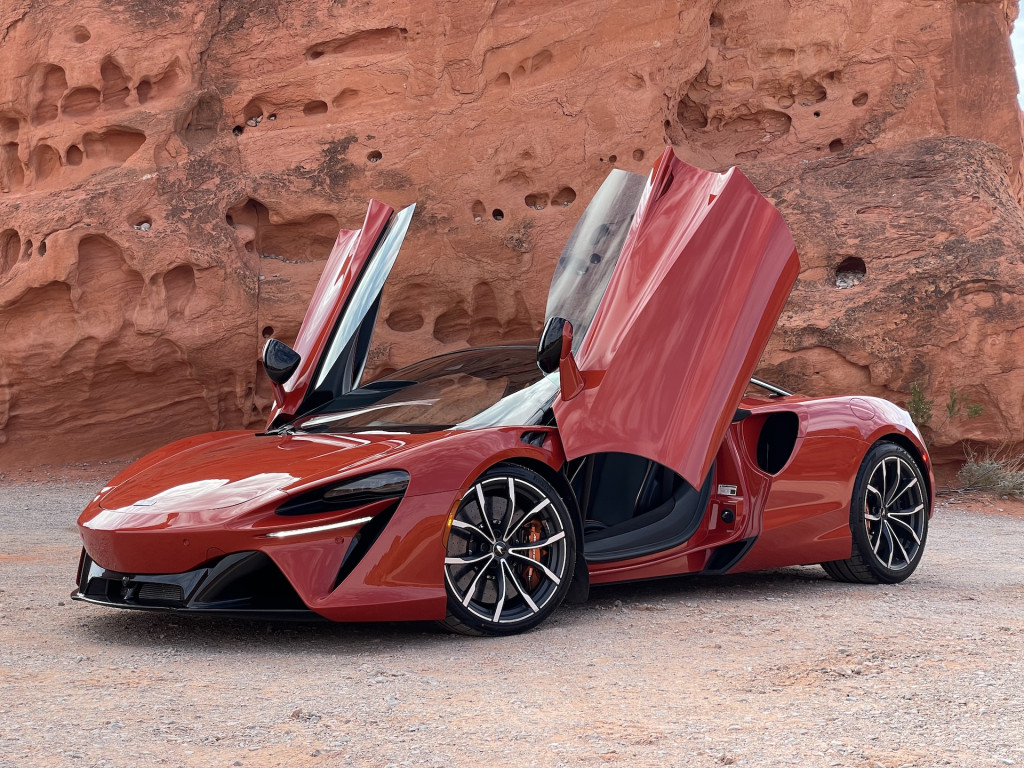
2023 McLaren Artura
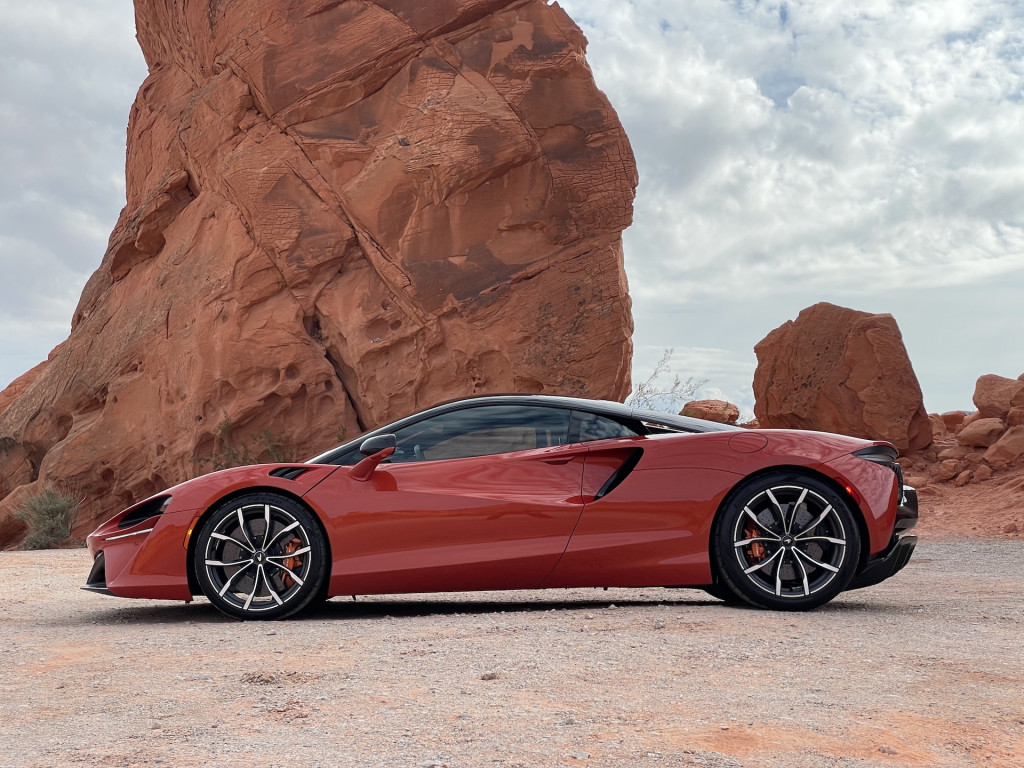
2023 McLaren Artura
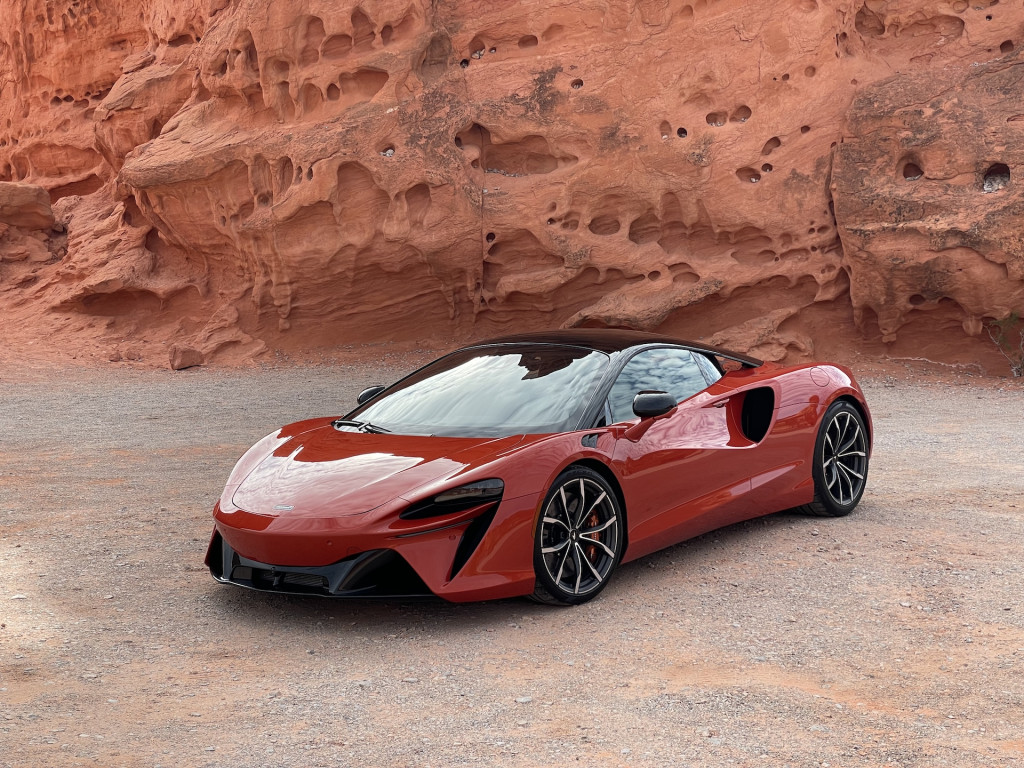
2023 McLaren Artura
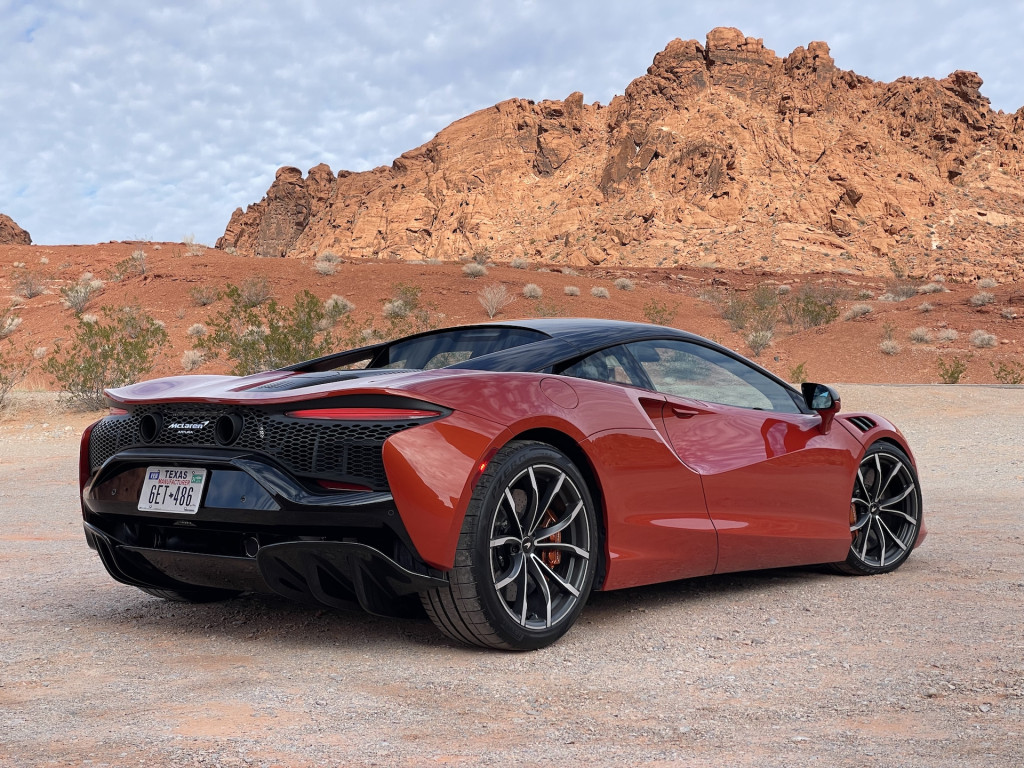
2023 McLaren Artura
94-hp economy car or 671-hp supercar
My test begins with a road drive from Las Vegas through the Valley of Fire state park to Boulder City, Nevada. It gives me a chance to test out the car’s four powertrain driving modes, which can turn the Artura into a 94-hp economy car or a 671-hp supercar.
In E-mode, the car runs only on the motor, and thus the Smart ForTwo power level. It has only 11 miles of range in this mode, according to the EPA (19 miles on the European WLTP cycle), and it dawdles along up to a speed of 81 mph. Standing on the throttle doesn’t start the engine, so E-mode is best for toddling through neighborhoods or sneaking out at night when you don’t want the family to know what you’re up to. Thanks to the electric motor, the Artura gets an EPA rating of 39 MPGe.
The battery, which charges to 80% in 2.5 hours on a 240-volt outlet, weighs 194 pounds and the motor 34 pounds. In total, the plug-in hybrid system adds 287 pounds, including the wiring for the 400-volt electrical system. The car tips the scales at a curb weight of just 3,303 pounds, though, less than a base BMW 3-Series, which is a tribute to McLaren’s pursuit of weight savings in every detail.
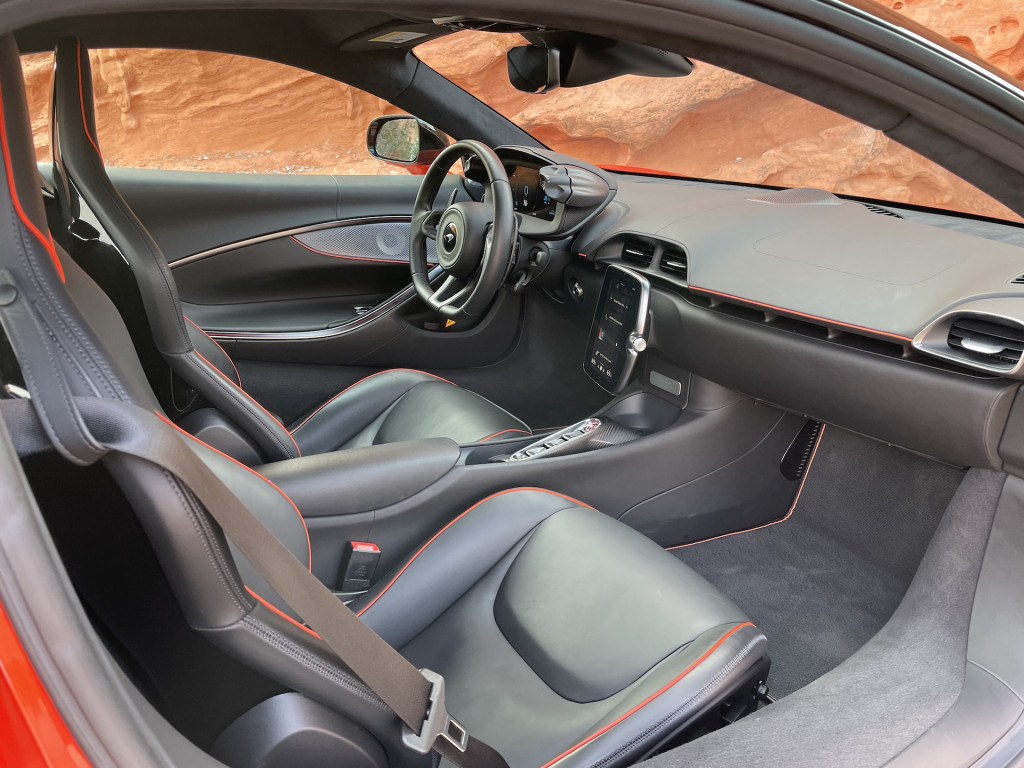
2023 McLaren Artura
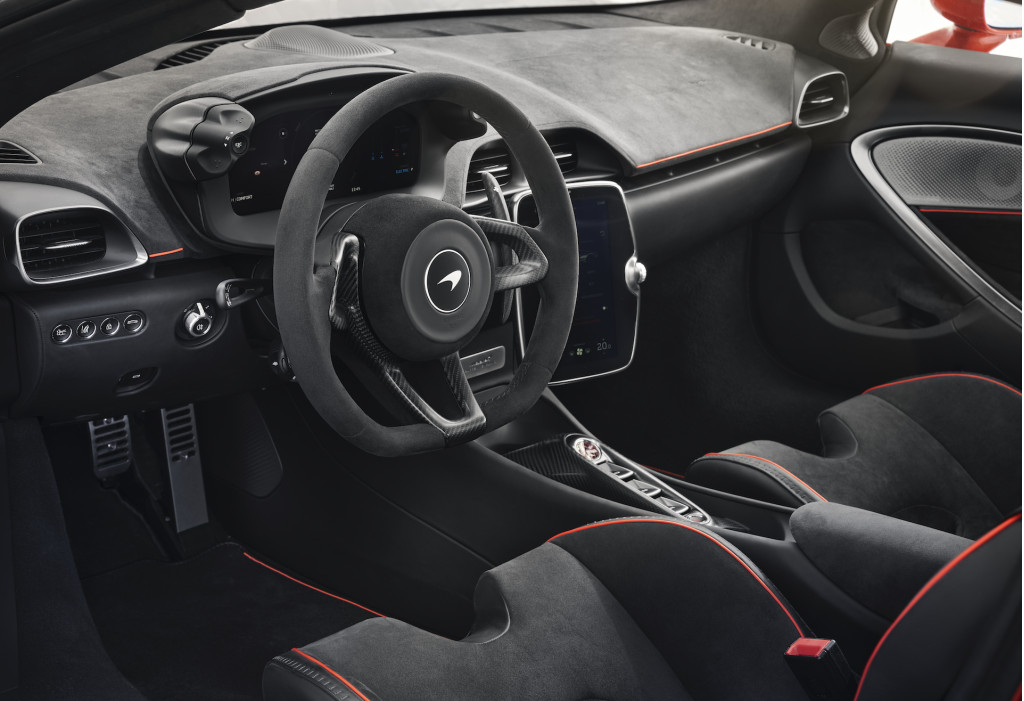
2023 McLaren Artura

2023 McLaren Artura
Next, I flick the toggle on the dash behind the right side of the steering wheel (rather than on the center console like in other McLarens) into Comfort mode. Here, it starts off with the electric motor as well, but the gas engines kicks in whenever it’s needed. The engine fires up smoothly enough and its throaty “whum” sound is pleasing to the ear, similar to a flat-6. The transmission grabs early shifts in Comfort mode and is occasionally tardy to downshift when the road opens up ahead and my foot digs deeper into the throttle. McLaren also programs the powertrain to keep a minimal charge in the battery in this mode, something around 5%.
Behind the left side of the steering wheel sits another mode selector, this one for the dampers. It has Comfort, Sport, and Track modes, and I spend the vast majority of my time in Comfort mode, which makes the car supple enough to drive on a regular basis. Sport mode and especially Track mode firm up the damping enough that bumps and ruts create abrupt up-and-down motions.
The powertrain’s Sport mode aims for about a 45% charge. The shifts come later in the rev range and become more responsive when it’s time to kick down to pass the masses in their transportation appliances.
My drive involves several miles of wide-open desert highways, and I find myself drawn to Track mode most often. It aims to keep the battery full, using extra engine revs to charge it. It also waits as long as possible on upshifts and quickens downshifts, though they can still dawdle a bit too much for my liking.
In Track especially, the plug-in hybrid powertrain provides willing power in large doses. It doesn’t feel like the wall of power you get with McLaren’s V-8, but that’s likely because it comes on more quickly, with the motor providing torque fill while the turbos spool up. It then just keeps revving willingly up to its 8,500-rpm redline in a relentless pursuit of speed. McLaren says it can launch from 0-60 mph in 3.0 seconds, and I believe it. If I wanted to, these open roads would provide enough room to test the car’s 205-mph top speed. I refrain from doing that. Honest. Speed runs have to wait for the track—well, most of them.
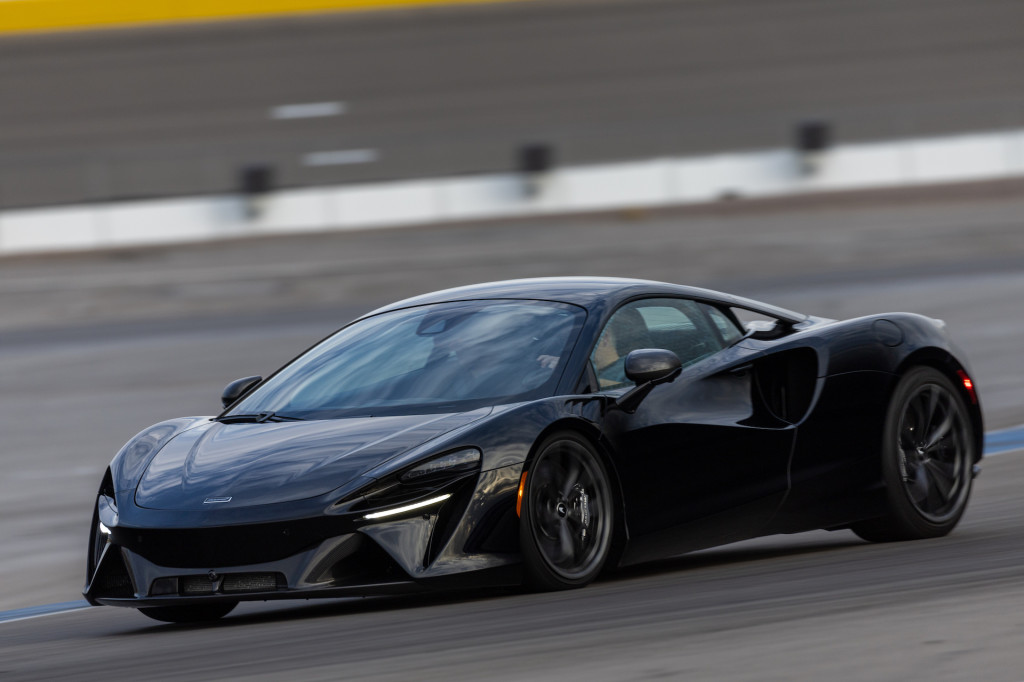
2023 McLaren Artura
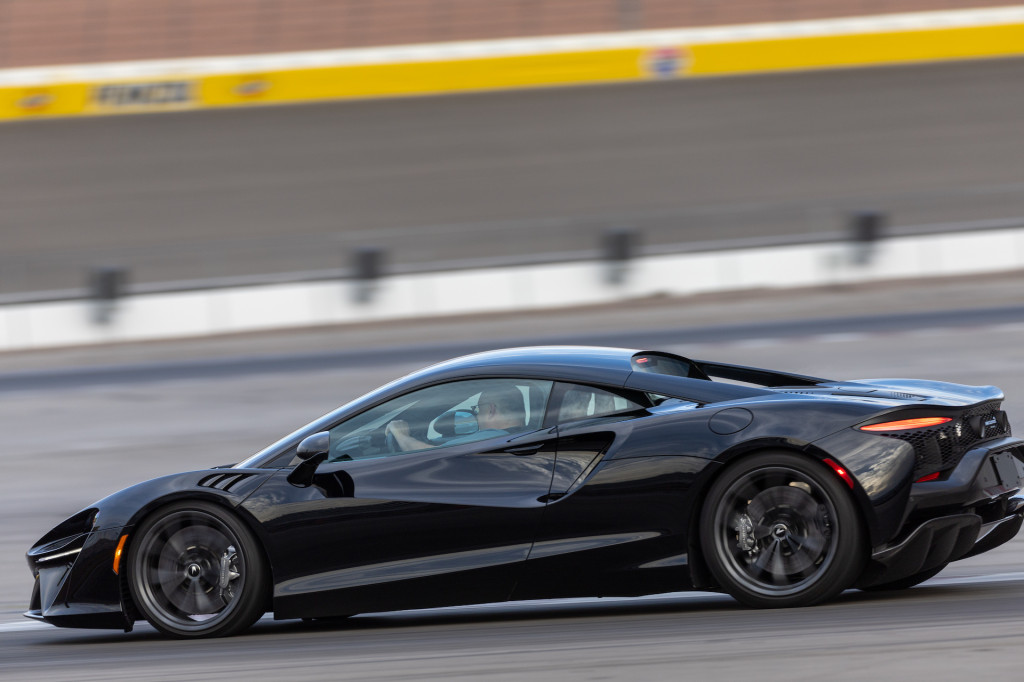
2023 McLaren Artura
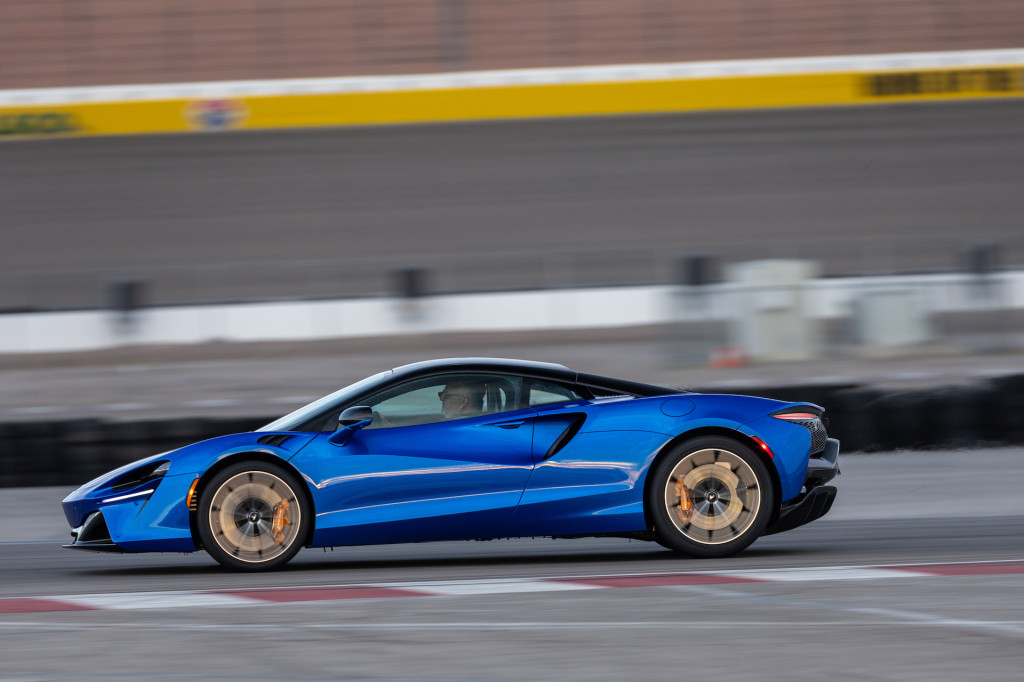
2023 McLaren Artura
Super track car
The drive ends with a couple of sessions on a small road course at Las Vegas Motor Speedway. It’s a tight, short nine-turn circuit, but a couple of the corners really test the car’s dynamic capabilities.
One grip of the small-diameter steering wheel and I’m in love. The Artura’s fantastic steering became evident on the road, but it really shines on the track. No variable assist, no variable ratios, just weighty, sharp hydraulic-assist power steering like sports cars and supercars had before the era of electric-assist power steering. It’s not too heavy for low-speed maneuvers, but its heft also makes it very stable mid-corner. If every car could have steering like this the world would be a better place.
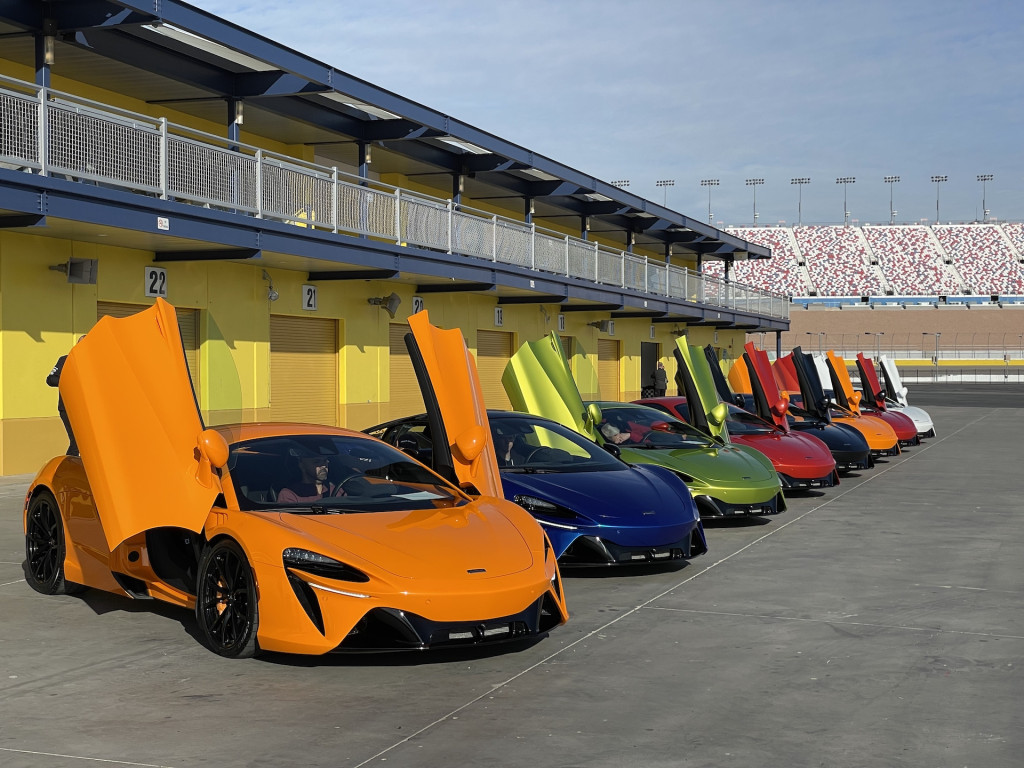
2023 McLaren Artura
The car reacts well to steering inputs, too. I run my first session in Sport mode, which firms up the adjustable dampers to make them a bit too stiff for everyday driving but great on this smooth track. There’s no slick hydraulic suspension here, like in the more expensive 720S. Instead, the Artura has a double-wishbone front suspension and a rear suspension with upper wishbones and two lower links. The suspension geometry works with the adjustable dampers to keep the wheels firmly planted on the ground. With its weight set so low and precious little ground clearance, the Artura has almost no lean in corners, and darts side to side like a great slot receiver.
The 180-degree Turn 2 is a tough challenge for any car. It requires patience as I try to carry as much speed as possible, and I feel a slight bit of push as I aim for the track-out point. Letting off the throttle helps the car tuck in and turn, and lifting abruptly can cause the rear end to go into a short slide. It’s a technique I might use to trigger a drift in the 15-setting Drift mode, but for this corner, I settle for the slight push in the interest of getting through the corner as fast as possible.
From corner to corner, the Artura’s hunkered down feeling inspires confidence. The 235/35R19 front and 295/35R20 rear Pirelli P Zero Corsa tires keep the car stuck to the pavement. McLaren says they have comparable grip to the extreme Pirelli P Zero Trofeo R tires from the 600LT hypercar. The e-diff puts the power down efficiently, and the car builds speed quickly. The track is just 1.2 miles, but it accelerates to more than 130 mph on the front straight from turn 9 to turn 1, which just goes to show how powerful this hybrid system is.

2023 McLaren Artura
I get so confident that I begin braking late for turn 1. That’s no problem, as the standard carbon-ceramic brakes (15.4-inch rotors up front with 6-piston calipers, 15.0-inch rotors out back with 4-piston calipers) offer a firm pedal and strong stopping power. Getting on them hard heats them enough to smoke after my first session, but I never detect any pedal fade or degradation of performance.
The pro driver in the passenger seat has me use the carbon-fiber shift paddles in my first run, and they are easy to access at all times because they are large and turn with the steering wheel. I shift mostly by ear, but the digital dash flashes red, then blue, and finally green accompanied by an audible beep at the shift point.
During my second session, I switch to the Track modes for the suspension and powertrain, and opt to let the transmission choose the shifts.
The car feels a little freer in Track mode, even without adjusting the stability control from its standard setting to Dynamic or off. I detect a bit more slip when I push the weight around too suddenly, but the car still feels rock steady in each corner.
Automatic mode for the transmission, however, isn’t ideal. The shifts sometimes bang into gear, even as I begin to steer into the next turn, and that upsets the car’s balance. It usually has the right gear to get the most power out of a corner, but those hard shifts spur me to go back to manual mode, which allows me to downshift in a straight line so as not to disrupt the car’s balance.
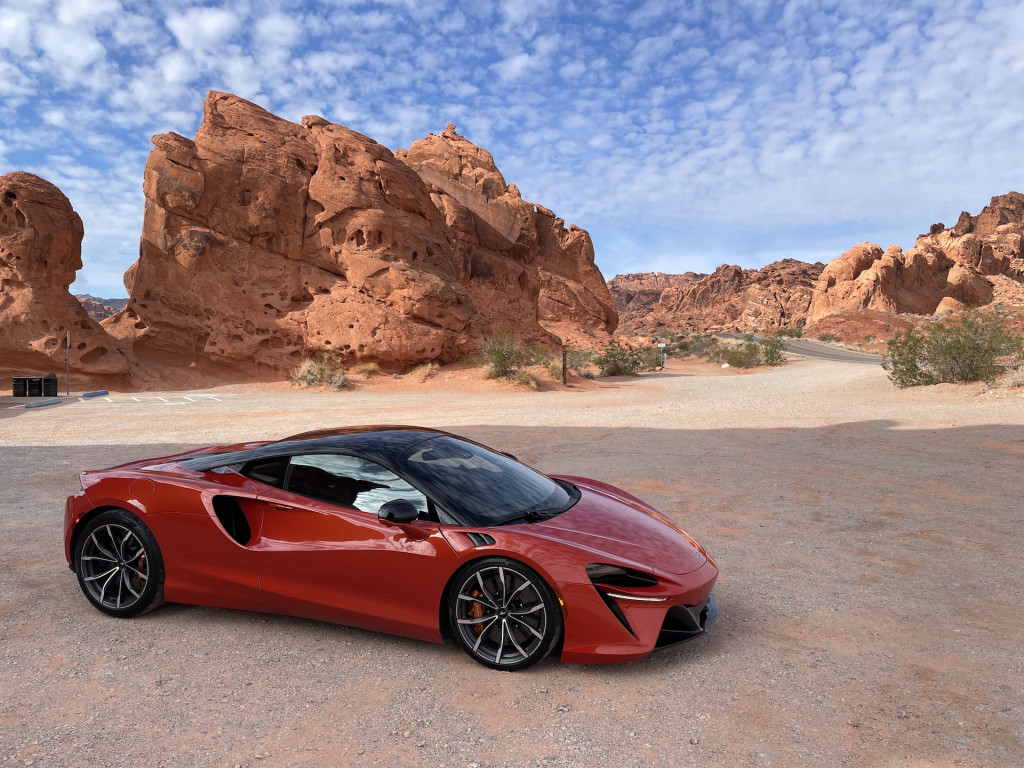
2023 McLaren Artura
The track sessions end too soon, and I find myself thinking this is as much McLaren as anyone might need. However, the Artura slots in as the lesser of the brand’s two Super Series cars. While the 720S flirts with $300,000 right out of the box, the Artura starts at $237,500, including a steep $4,500 destination charge. The price includes new safety features, namely adaptive cruise control, lane-departure warnings, and traffic-sign recognition. It also includes a 10.0-inch digital instrument cluster, and an 8.0-inch portrait-style center touchscreen that now incorporates Apple CarPlay and Android Auto and can receive over-the-air updates.
The Artura represents the next generation of McLaren performance. Even though it adds weight through a plug-in hybrid powertrain, it sticks with the company’s race-bred principles. The result is an engaging street machine, a track car to chase faster and faster times, and an economy car all rolled into one. It’s proof that McLaren can expand the capabilities of its cars as it moves into the electric era without sacrificing its core ideals.
McLaren paid for travel, lodging, and track time for Motor Authority to bring you this firsthand report.

